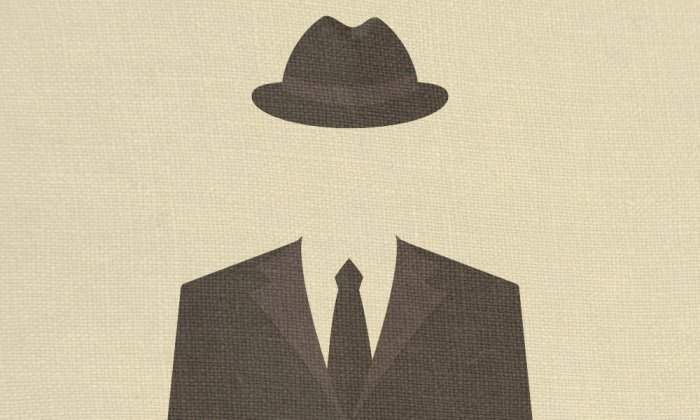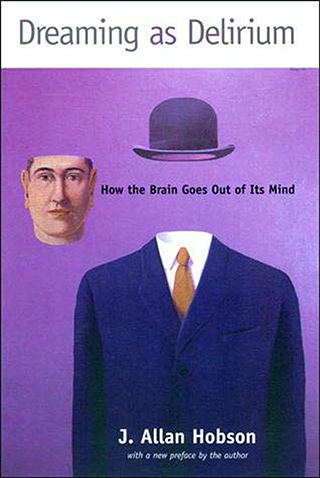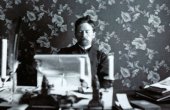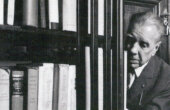J. Allan Hobson: ‘That Car Looks Like It’s Been In an Accident’

The following article is excerpted from J. Allan Hobson’s 1999 book “Dreaming as Delirium: How the Brain Goes Out of Its Mind.” Hobson, a Harvard psychiatrist, pioneering sleep researcher, and prolific author, died in 2021.
I was standing on the sidewalk in front of a 19th-century apartment house on the Quai Aristide Briand in Lyon, France, when the narrative networks of my brain emitted an ominous announcement: That car looks like it’s been in an accident. And indeed, the rear end of the English Riley 1.5 parked next to the curb was a mess — as if some other car had driven into it at considerable speed. The crowd of passersby that had gathered to survey the wreck, and discuss its possible cause in heated Gallic debate, indicated that the accident must have been recent. It was hard for me to tell, exactly, because I had trouble understanding their French. Then I had a very alarming thought.

However damaged, that looks like my car. But it couldn’t be, I told myself. There is nothing wrong with my car. Then I noticed that down the road about a hundred yards was a small blue French Renault with a bridge abutment sticking up through its hood like the Eiffel Tower. Another crowd of garrulous and gesticulating Frenchmen was trying to extricate the driver from the crumpled front seat of that vehicle.
I wonder how the driver of this car [referring to the one that looked like mine] is doing? I asked myself. He must be okay, because there is no one in the car and there is no one lying on the sidewalk.
A member of the argumentative crowd that had gathered around the car before me then asked me some questions that I couldn’t understand well enough to respond. I just smiled helplessly as I usually do when at a loss in a foreign country — or a strange situation — and that seemed to satisfy the group. They went back to gesticulating and, as I gathered from their gestures, to arguing about what had happened and who might have been at fault. By this time a policeman had arrived, as well as an ambulance that emitted a terrifying honk instead of a siren.
I looked at the car again.
Practically totaled, I concluded. I’m glad it just looks like mine. Amazing coincidence. Black (just like mine), cute little English four-seater (just like mine), red leather bucket seats (just like mine), walnut dashboard (just like mine), Riley 1.5, rare make (just like mine). Extremely difficult to repair, said my narrative network.
All the features of the wreck matched those of my own car. Even the license plate, Rhode Island, MD 353, which could be seen in the crumpled folds of the bashed trunk, matched those of my vehicle. I was surprised by all these details but was at something of a loss to understand how such coincidences could be explained.
Yet I wasn’t disoriented. I knew who I was. I knew it was Saturday, October 9, 1963. And I even knew that I was standing on the sidewalk of the Quai Aristide Briand, which runs alongside the Rhône River. I promptly recognized my wife, Joan, when she shouldered her way through the crowd and asked me, ”Are you okay?”
“Okay? Of course I’m okay. But look at that car. What a mess! Glad it’s not ours. It just looks like ours,” I reassured her.
“But it is our car,” she asserted, “and when I went into the house to pick up the babysitter, you were sitting in the driver’s seat.”
“Oh yes,” I said, without any real conviction and promptly forgot what I had just been told.
“From the babysitter’s apartment above I heard the crash;’ she continued. “Some drunk ran into you from behind. Both his legs are broken!”
“How dreadful” was the best I could do for him. I could see that he had been extricated from his car and was about to be whisked off to the hospital by the mournfully honking ambulance. Since my wife had identified me as the driver of the stove-in Riley, the policeman was now asking me a lot of questions. But I was not giving him what he wanted. “Too bad he doesn’t speak French as well as you, madame,” he said to my wife (in French, of course).
“But his French is usually fluent,” Joan told him. “There must be something wrong with his head. He can’t seem to remember anything.”
Joan’s diagnosis didn’t slow the gendarme down any. He and the sidewalk jury all agreed with me that I was fine. “N’inquietez vous,” he said, meaning, “Not to worry.”
But I did have some concern about our one-year-old son. “How is Ian?” I asked.
“Fine,” Joan said. “He is at home.”
I still had enough self-reflective awareness to realize I could not form a record of my frightening experience. I did not have enough memory to make a lasting, useful set of representations of my extremely perilous state or even to create a story explaining what had caused me to be so dim. And in my insistence that I was fine, I really thought I was fine. I wasn’t deliberately confabulating either. Meanwhile, the gendarme was behaving with a bureaucratic thoroughness that matched his medical incompetence. We would be well advised to call a huissier, the gendarme kept saying. Neither Joan nor I, at our best, knew that huissier was the French equivalent of “justice of the peace,” a public official whose documentation of a serious accident is required by insurance companies, especially when there has been severe bodily injury. The babysitter’s mother not only translated this rare French word but called up a live one on the telephone.
Before this worthy’s arrival — and no more than 10 minutes after my memory had been blasted out of that bucket seat — I began to feel distinctly woozy. I don’t recall whether the lights went all the way out, but I was suddenly on my back on the sidewalk.
Before long, I too was laid out in an ambulance. With Joan riding shotgun, the ambulance honked and careened along the quai toward the emergency room of the Grange Blanche Hospital. The hospital actually sits right across the Boulevard Rockefeller from the medical school in Lyon where I had been studying the control of conscious states by the brain stem. I was scared. I knew I had amnesia and I knew I was in shock. The “onk-onk” of the ambulance seemed to go straight to the anxiety center in my brain, which responded by sending back rhythmic waves of panic.
Yet I was not disoriented. I could more or less visualize the whole ambulance trip on the map of Lyon in my mind. And in the emergency ward, when I found that I could sit if not stand, I was even able to help Joan and the intern get through the mental status exam! But I still couldn’t give them a history of the accident. I had no recent memory. I could formulate no propositions about the recent past. And even though I was a doctor and a brain specialist, I could offer no explanation about why I was amnesic. Although the honking had stopped, I still felt scared.
Despite my objections, the doctors decided to admit me for observation. I hate hospitals, at least when I’m the patient. And I felt pretty sure that I was already getting better. My French was coming back. I even remembered going out to dinner the night before and that we were headed for a rugby game when I got clobbered outside the babysitter’s house. And — last of all — I remembered that my cousin George was coming the next evening with a promise to take us to dinner at Fernand Point’s La Pyramide Restaurant in nearby Vienne. I wasn’t going to miss that one even if I was delirious.
But I had to admit that I still couldn’t remember the accident at all. Joan had to keep telling me about it and reassuring me about Ian. So before she left to go home to take care of him, she wrote me a narrative script that could serve as a stand-in for my lost memory. The observation ward in which I lay was not comforting. The man in the bed next to mine was comatose and gurgling. To rule out the supposition that I too might be dying, I read my script, which said: “You’ve been in an accident.” “The car is badly damaged.”
“Ian is fine.”
“I am fine [meaning Joan].”
“The guy in the next bed is in much worse shape than you are!”
It worked for long enough to let me doze. Then I was awakened by the gurgling from the next bed. And again I read the script. And again I slept.
This cycle repeated itself throughout the evening until I finally fell into a long and deep sleep. By morning, when the neurologists made their rounds, I really was fine. My mental status exam was normal: I was oriented to time, place, and person; my recent memory was intact; and my emotions were stable. My blood pressure was normal. The formulation of the events of the accident, and its effect on my brain-mind, which the French doctors and I made together — in French — was crystal clear. Here is the formulation we elaborated:
I was sitting in the driver’s seat of my Riley 1.5 waiting for my wife to come downstairs with the babysitter we were picking up to take care of Ian, so we could go to a rugby game. I was double-parked on a road on which people often speed, and I could remember nervously eyeing the rearview mirror. Although there were two other free lanes between me and the Rhône River, I was astonished to see the ever-enlarging image of a Renault weaving its way toward me. Paralyzed with fear, and having inadequate time to move my car or jump out of it, I was struck from behind and my car was violently accelerated forward. But since inertia held most of me still, my head snapped backward as the bucket seat shot forward against my back. It was whiplash at its worst.
The mental image of a snapping whip helped the doctors and me visualize the sudden S-shaped deformation my brain stem underwent when my head first snapped back away from my body when the car was hit, then rebounded forward again as the car rapidly decelerated and stopped. My head probably didn’t move farther than a foot and a half off its usual vertical alignment with my body, and since there was no evidence of any impact to my head on either its backward or forward flight, we assumed, simply, that my brain stem, the soft spongy bit of tissue that makes me breathe and dream, was just twisted and tugged a whole lot more than it likes to be.
If I had hit my head on the steering wheel, the amnesia that I suffered would have been easy to explain. In such a case the temporal lobes are jostled by an effect called contre-coup (meaning “against the blow”). This is what happens to a boxer whose head is rocked back so fast by a knockout punch that it leaves his brain behind; his brain crashes into the front wall of his skull. After too many such bouts a boxer’s memory may leave him for good.
Even though my head hit nothing, my brain may have crashed against the front wall of my skull as the car rapidly decelerated. That entirely internal impact may have added the insult of temporal lobe concussion to the injury of brain-stem whiplash.
Considering that I was able to recover so quickly, my brain was probably not even bruised. What really happened to my brain that day I will never know, which is too bad because it could tell me a lot. In addition to the sudden and dramatic amnesia about the accident, I had a partial loss of many representations of the previous months. Most strikingly, my hard-earned fluency in French had temporarily disappeared.
Until my blood pressure took a dive on the sidewalk, and I with it, we assumed that whatever went wrong was mainly neuronal. I supposed that the tug caused some local changes in blood supply so that the neurons were temporarily short of oxygen or were perhaps bathed in a slight but suddenly quite different concentration of salt. I also wondered if the modulatory neurons on which I de pended to hold data in working memory might have decreased their output below a critical level. To anyone who wanted to know what was going on, I was suddenly about as useful as a cabbage.
The rest of my brain was actually fine, however, so I had gotten out of the car, walked around to what used to be its rear end, and said to myself, That car looks like it’s been in an accident.
The Grange Blanche neurologists agreed with my theory about my state, but they weren’t about to let me leave the hospital until they had run a lot of tests. They naturally wanted to protect themselves — and me I suppose — from the oversight of some alternative explanation. But I still wanted out. So I said that since my lab colleagues at the medical school were all neurologists, I would be under constant surveillance. And I agreed to sign a release and to get all the tests done as an outpatient.
They still didn’t look happy. So I played my trump card, my cousin’s dinner invitation. When they heard I was going to La Pyramide and that someone else was going to be paying the bill, they all smiled at each other with gastronomic glee and said, “Va-t-on,” meaning, “Beat it.” I shall never forget that dinner!
J. Allan Hobson was a Harvard psychiatrist who pioneered the first serious scientific alternative to Freud’s ideas about dreams. He was the author of close to two dozen books, including “Dreaming as Delirium,” from which this article is excerpted.



